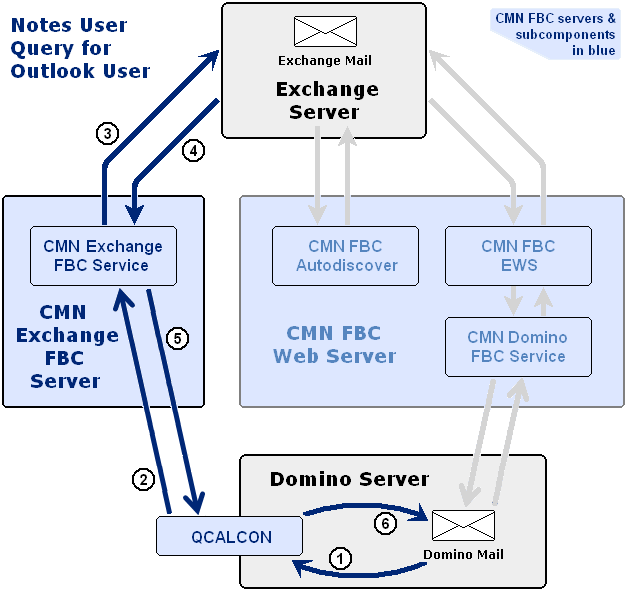Notes user retrieves F/B data for an Outlook user
In this scenario, Joe (a Lotus Notes user) wants to book a meeting with Sally, an Outlook user, whose address is sally@e‑sitraka.com:
FBC installation and configuration
The configuration procedures for different combinations of these factors are lengthy and complex, and therefore are documented in a separate FBC Scenarios Guide that accompanies the other documentation in the CMN product kit. See the FBC Scenarios Guide for procedures and application notes for installing and configuring CMN’s Free/Busy Connector in all of these Exchange-side scenarios:
CMN’s F/B Connector also supports several variations to the primary scenarios listed above. Accommodations for these variations are included in the configuration instructions in the FBC Scenarios Guide, and we summarize them briefly here:
|
• |
Multi-Domain Support: The Free/Busy Connector can facilitate the exchange of F/B information among multiple subdomains supported by both the Exchange and Domino servers. |
|
• |
Multiple Domino Servers: CMN supports sharing F/B information between multiple Domino servers and a single Exchange server. |
|
• |
Domino Clusters: CMN supports a cluster of Domino servers (ClusterNode1 and ClusterNode2) that provide Lotus Notes mail service in an active/standby redundancy configuration. In this case, only a single CMN Web Server is required to support both Domino servers. |
F/B Connector Performance Counters
The Quest CMN Free/Busy Connector includes these performance counters:
|
• |
Quest CMN To Exchange Free/Busy [queries from Notes users for Exchange users’ F/B data]: |
|
• |
Quest CMN To Domino Free/Busy [queries from Exchange users for Notes users’ F/B data]: |
F/B Connector Management Console
|
• |
Exchange Free Busy Connector screens configure CMN components that facilitate Notes queries for Exchange F/B info. |
|
• |
Notes Free Busy Connector screens configure CMN components that facilitate Exchange queries for Notes F/B info. |
Chapter 1 of the User Guide explains the basic operating concepts for the CMN Management Console. The topics below provide field notes for the Management Console screens that pertain to the Free/Busy Connector.

